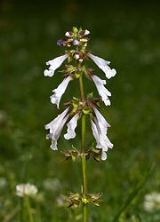
Salvia lyrata
Encyclopedia
Salvia lyrata is a herbaceous perennial in the family Lamiaceae
that is native to the United States
, from Connecticut
west to Missouri
, and in the south from Florida
east to Texas
. It was described and named by Carolus Linnaeus
in 1753.
. The center vein is sometimes dark wine-purple. A hairy stem up to 2 foot (0.6096 m) long grows from the rosette, with uneven whorls of two-lipped lavender to blue flowers. Flowering is heaviest between April and June, though sparse flowering can happen throughout the year. The leaves were once thought to be an external cure for cancer, thus one of the common names "Cancerweed". Salvia lyrata grows in full sun or light to medium shade, with native stands found on roadsides, fields, and open woodlands.
s for its attractive foliage and flowers, though it can prolifically seed, easily becoming a lawn weed. Several cultivar
s have been developed with purple leaves. 'Burgundy Bliss' and 'Purple Knockout' are two cultivars with burgundy leaves that are deeper in color than the species. Native Americans used the root as a salve for sores, and used the whole plant as a tea for colds and coughs.
Lamiaceae
The mints, taxonomically known as Lamiaceae or Labiatae, are a family of flowering plants. They have traditionally been considered closely related to Verbenaceae, but in the 1990s, phylogenetic studies suggested that many genera classified in Verbenaceae belong instead in Lamiaceae...
that is native to the United States
United States
The United States of America is a federal constitutional republic comprising fifty states and a federal district...
, from Connecticut
Connecticut
Connecticut is a state in the New England region of the northeastern United States. It is bordered by Rhode Island to the east, Massachusetts to the north, and the state of New York to the west and the south .Connecticut is named for the Connecticut River, the major U.S. river that approximately...
west to Missouri
Missouri
Missouri is a US state located in the Midwestern United States, bordered by Iowa, Illinois, Kentucky, Tennessee, Arkansas, Oklahoma, Kansas and Nebraska. With a 2010 population of 5,988,927, Missouri is the 18th most populous state in the nation and the fifth most populous in the Midwest. It...
, and in the south from Florida
Florida
Florida is a state in the southeastern United States, located on the nation's Atlantic and Gulf coasts. It is bordered to the west by the Gulf of Mexico, to the north by Alabama and Georgia and to the east by the Atlantic Ocean. With a population of 18,801,310 as measured by the 2010 census, it...
east to Texas
Texas
Texas is the second largest U.S. state by both area and population, and the largest state by area in the contiguous United States.The name, based on the Caddo word "Tejas" meaning "friends" or "allies", was applied by the Spanish to the Caddo themselves and to the region of their settlement in...
. It was described and named by Carolus Linnaeus
Carolus Linnaeus
Carl Linnaeus , also known after his ennoblement as , was a Swedish botanist, physician, and zoologist, who laid the foundations for the modern scheme of binomial nomenclature. He is known as the father of modern taxonomy, and is also considered one of the fathers of modern ecology...
in 1753.
Description
Salvia lyrata forms a basal rosette of leaves that are up to 8 inches (20.3 cm) long, broadening toward the tip. The leaves have irregular margins and are typically pinnately lobed or cut, looking somewhat like a lyreLyre
The lyre is a stringed musical instrument known for its use in Greek classical antiquity and later. The word comes from the Greek "λύρα" and the earliest reference to the word is the Mycenaean Greek ru-ra-ta-e, meaning "lyrists", written in Linear B syllabic script...
. The center vein is sometimes dark wine-purple. A hairy stem up to 2 foot (0.6096 m) long grows from the rosette, with uneven whorls of two-lipped lavender to blue flowers. Flowering is heaviest between April and June, though sparse flowering can happen throughout the year. The leaves were once thought to be an external cure for cancer, thus one of the common names "Cancerweed". Salvia lyrata grows in full sun or light to medium shade, with native stands found on roadsides, fields, and open woodlands.
Cultivation and uses
Salvia lyrata is sometimes grown in gardenGarden
A garden is a planned space, usually outdoors, set aside for the display, cultivation, and enjoyment of plants and other forms of nature. The garden can incorporate both natural and man-made materials. The most common form today is known as a residential garden, but the term garden has...
s for its attractive foliage and flowers, though it can prolifically seed, easily becoming a lawn weed. Several cultivar
Cultivar
A cultivar'Cultivar has two meanings as explained under Formal definition. When used in reference to a taxon, the word does not apply to an individual plant but to all those plants sharing the unique characteristics that define the cultivar. is a plant or group of plants selected for desirable...
s have been developed with purple leaves. 'Burgundy Bliss' and 'Purple Knockout' are two cultivars with burgundy leaves that are deeper in color than the species. Native Americans used the root as a salve for sores, and used the whole plant as a tea for colds and coughs.

